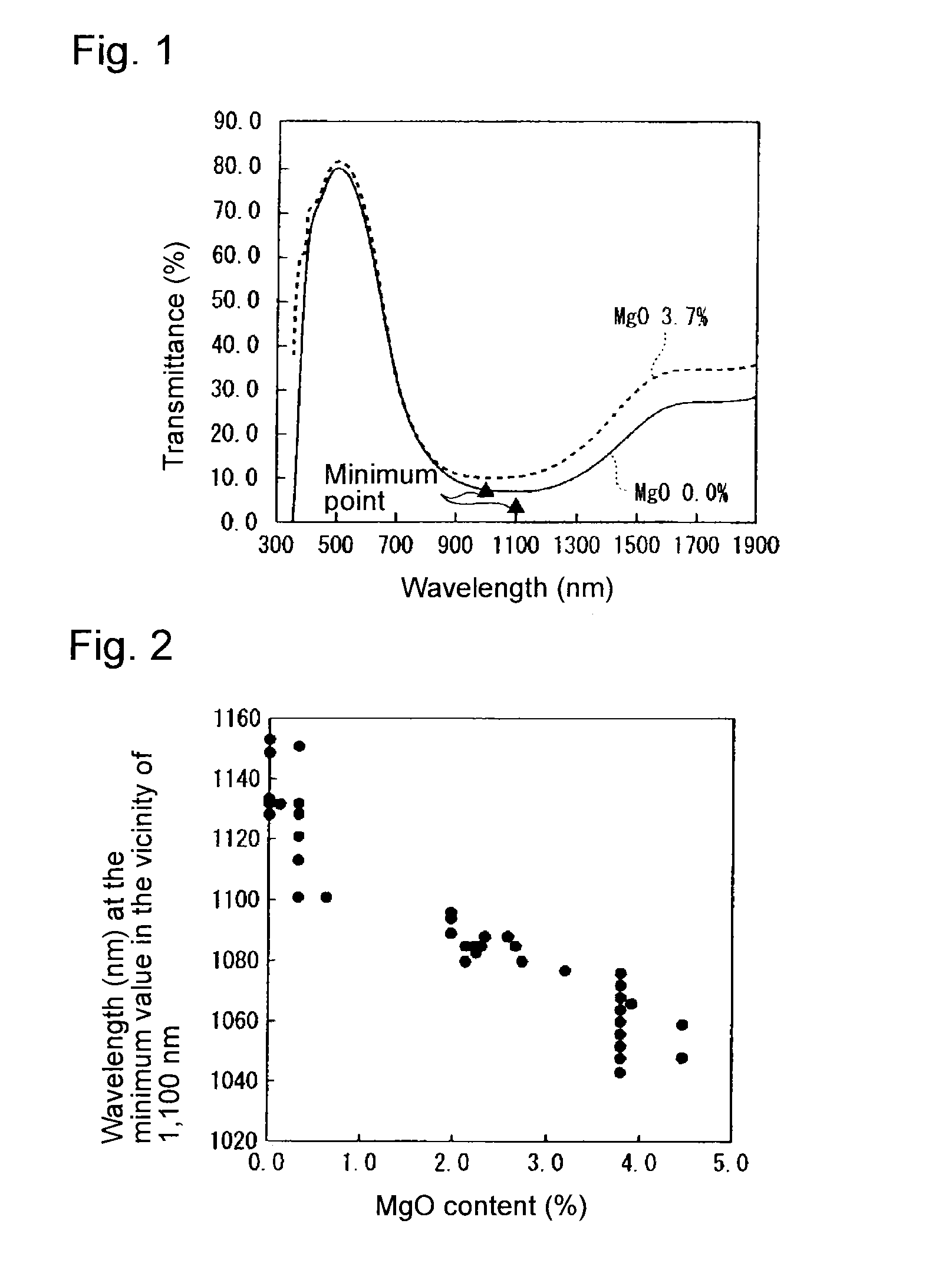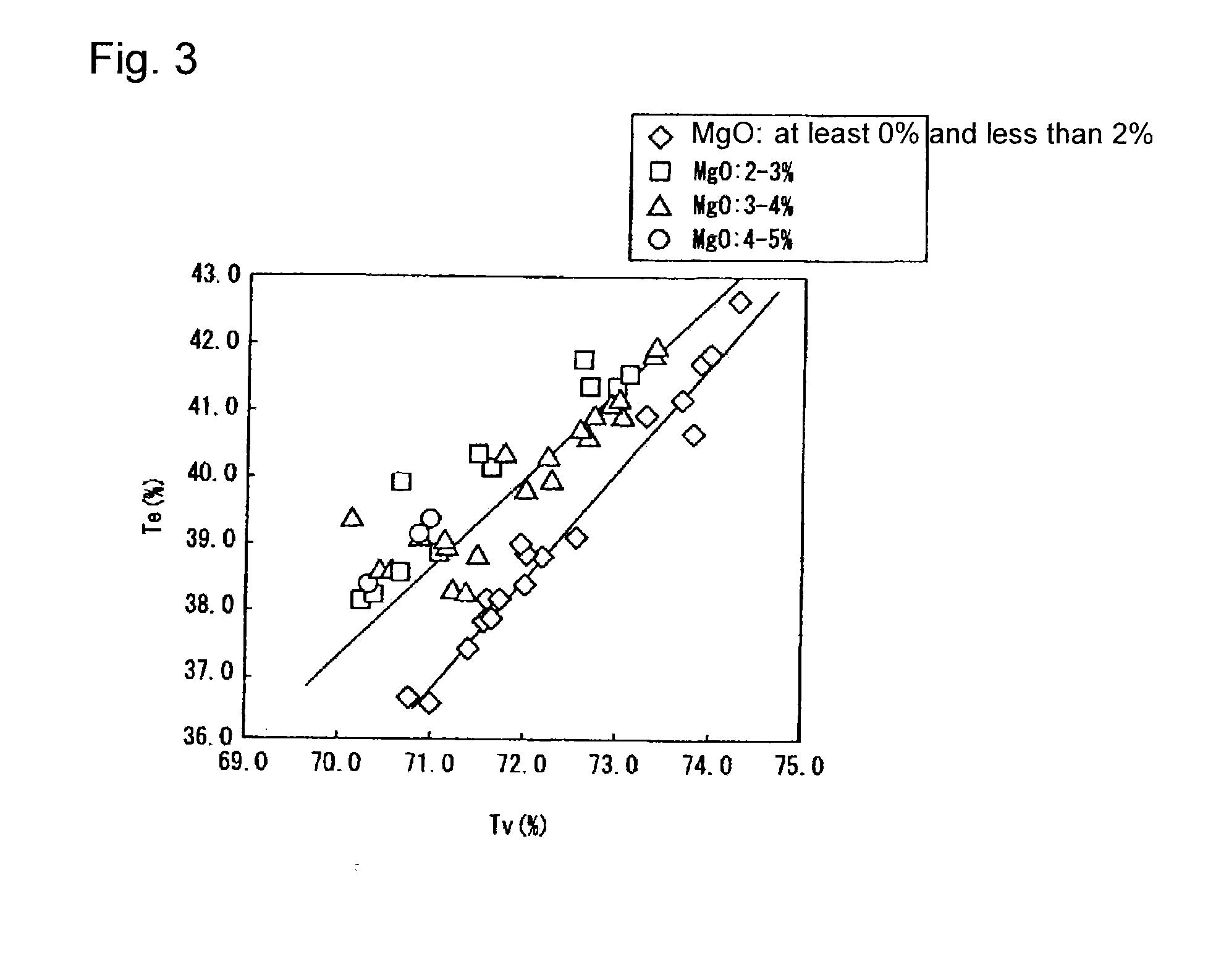Heat-absorbing glass plate and process for its production
a technology of heat-absorbing glass and glass plate, which is applied in the field of heat-absorbing glass plate, can solve the problems of impurities, costs and inclusion of impurities when the glass base is changed, and achieve the effects of low ultraviolet transmittance, low solar transmittance and high visible light transmittan
- Summary
- Abstract
- Description
- Claims
- Application Information
AI Technical Summary
Benefits of technology
Problems solved by technology
Method used
Image
Examples
examples
[0173]Now, the present invention will be described in detail with reference to Examples. However, it should be understood that the present invention is by no means restricted to such specific Examples.
[0174]Examples 1 to 18 and 21 to 28 are Examples of the present invention, and Examples 19 and 20 are Comparative Examples.
(Redox)
[0175]With respect to the obtained glass plate, Redox was calculated in accordance with the following formula from a spectral curve of glass measured by a spectrophotometer:
Redox(%)=−log e(T1000 nm / 91.4) / (Fe2O3 amount×t×20.79)×100
[0176]In the above formula, T1000 nm is the transmittance (%) of the glass plate at a wavelength of 1,000 nm, t is the thickness (cm) of the glass plate, and the Fe2O3 amount is the content (%=mass percentage) of total iron as calculated as Fe2O3.
(Te)
[0177]With respect to the obtained glass plate, the solar transmittance (Te) as defined in JIS R3106 was obtained as a value calculated as 4 mm thickness.
(Tv)
[0178]With respect to the o...
examples 1 to 28
[0183]The respective materials were mixed to achieve compositions as identified in Tables 1 to 5 to prepare glass raw materials. Each glass raw material was put into a crucible and heated in an electric furnace at 1,500° C. to form molten glass. The molten glass was cast on a carbon plate and cooled. Both surfaces of the obtained plate-form glass were polished to obtain a glass plate having a thickness of 4 mm. With respect to the glass plate, the transmittance was measured every 1 nm by using a spectrophotometer (manufactured by PerkinElmer Co., Ltd., Lambda 950) to determine Te, Tv, Tuv and Dw. Further, the above glass was polished to a thickness of 2 mm, and with respect to this glass plate, the transmittance was measured every 1 cm−1 by FT-IR (manufactured by Thermo Nicolet Corporation, Thermo Nicolet Avatar 370), and β—OH was obtained based on the above formula. The results are shown in Tables 1 to 5.
TABLE 1Ex. 1Ex. 2Ex. 3Ex. 4Ex. 5CompositionSiO268.968.969.068.668.7(%)Al2O33.5...
PUM
| Property | Measurement | Unit |
|---|---|---|
| thickness | aaaaa | aaaaa |
| solar transmittance | aaaaa | aaaaa |
| visible light transmittance | aaaaa | aaaaa |
Abstract
Description
Claims
Application Information
 Login to View More
Login to View More - R&D
- Intellectual Property
- Life Sciences
- Materials
- Tech Scout
- Unparalleled Data Quality
- Higher Quality Content
- 60% Fewer Hallucinations
Browse by: Latest US Patents, China's latest patents, Technical Efficacy Thesaurus, Application Domain, Technology Topic, Popular Technical Reports.
© 2025 PatSnap. All rights reserved.Legal|Privacy policy|Modern Slavery Act Transparency Statement|Sitemap|About US| Contact US: help@patsnap.com


